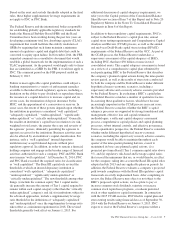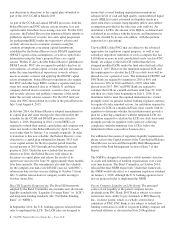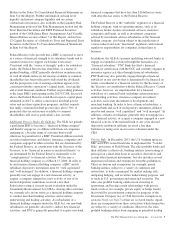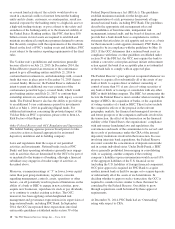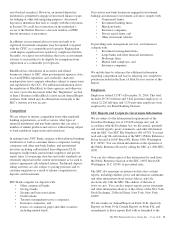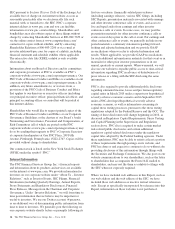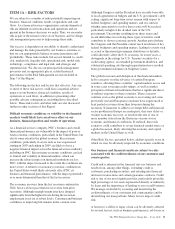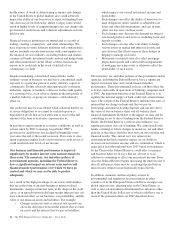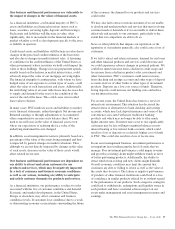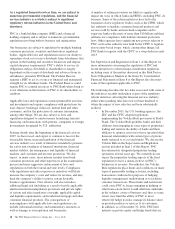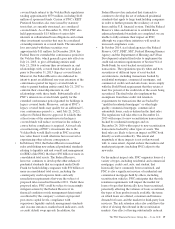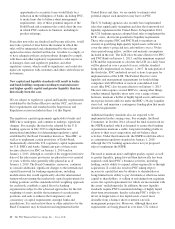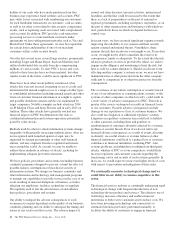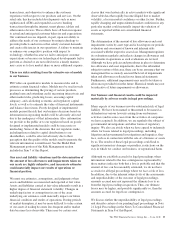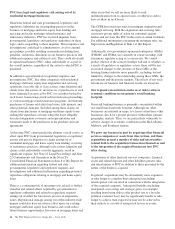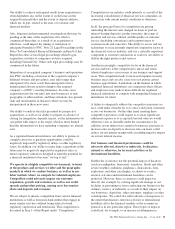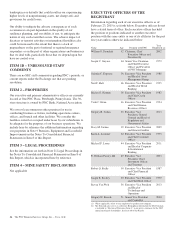PNC Bank 2014 Annual Report Download - page 34
Download and view the complete annual report
Please find page 34 of the 2014 PNC Bank annual report below. You can navigate through the pages in the report by either clicking on the pages listed below, or by using the keyword search tool below to find specific information within the annual report.health issues. A weak or deteriorating economy and changes
in the United States or global markets also could adversely
impact the ability of our borrowers to repay outstanding loans.
Any decrease in our borrowers’ ability to repay loans would
result in higher levels of nonperforming loans, net charge-offs,
provision for credit losses and valuation adjustments on loans
held for sale.
Financial services institutions are interrelated as a result of
trading, clearing, counterparty, and other relationships. We
have exposure to many different industries and counterparties,
and we routinely execute transactions with counterparties in
the financial services industry, including brokers and dealers,
commercial banks, investment banks, mutual and hedge funds,
and other institutional clients. Many of these transactions
expose us to credit risk in the event of default of our
counterparty or client.
Despite maintaining a diversified loan portfolio, in the
ordinary course of business, we may have concentrated credit
exposure to a particular person or entity, industry, region or
counterparty. Events adversely affecting specific customers,
industries, regions or markets, a decrease in the credit quality
of a customer base, or an adverse change in the risk profile of
a market, industry, or group of customers could adversely
affect us.
Our credit risk may be exacerbated when collateral held by us
to secure obligations to us cannot be realized upon or is
liquidated at prices that are not sufficient to recover the full
amount of the loan or derivative exposure due us.
In part due to improvement in economic conditions, as well as
actions taken by PNC to manage its portfolio, PNC’s
provision for credit losses has declined substantially every
year since the end of the recent recession. If we were to once
again experience higher levels of provision for credit losses, it
could result in lower levels of net income.
Our business and financial performance is impacted
significantly by market interest rates and movements in
those rates. The monetary, tax and other policies of
governmental agencies, including the Federal Reserve,
have a significant impact on interest rates and overall
financial market performance over which we have no
control and which we may not be able to predict
adequately.
As a result of the high percentage of our assets and liabilities
that are in the form of interest-bearing or interest-related
instruments, changes in interest rates, in the shape of the yield
curve, or in spreads between different market interest rates can
have a material effect on our business, our profitability and the
value of our financial assets and liabilities. For example:
• Changes in interest rates or interest rate spreads can
affect the difference between the interest that we earn
on assets and the interest that we pay on liabilities,
which impacts our overall net interest income and
profitability.
• Such changes can affect the ability of borrowers to
meet obligations under variable or adjustable rate
loans and other debt instruments, and can, in turn,
affect our loss rates on those assets.
• Such changes may decrease the demand for interest
rate-based products and services, including loans and
deposit accounts.
• Such changes can also affect our ability to hedge
various forms of market and interest rate risk and
may decrease the effectiveness of those hedges in
helping to manage such risks.
• Movements in interest rates also affect mortgage
prepayment speeds and could result in impairments
of mortgage servicing assets or otherwise affect the
profitability of such assets.
The monetary, tax and other policies of the government and its
agencies, including the Federal Reserve, have a significant
impact on interest rates and overall financial market
performance. These governmental policies can thus affect the
activities and results of operations of banking companies such
as PNC. An important function of the Federal Reserve is to
regulate the national supply of bank credit and certain interest
rates. The actions of the Federal Reserve influence the rates of
interest that we charge on loans and that we pay on
borrowings and interest-bearing deposits and can also affect
the value of our on-balance sheet and off-balance sheet
financial instruments. Both due to the impact on rates and by
controlling access to direct funding from the Federal Reserve
Banks, the Federal Reserve’s policies also influence, to a
significant extent, our cost of funding. We cannot predict the
nature or timing of future changes in monetary, tax and other
policies or the effects that they may have on our activities and
financial results. The current very low interest rate
environment has had a negative impact on our ability to
increase our net interest income, and its continuation, which is
expected at least through mid-year 2015 based on statements
by the Chair of the Federal Reserve, could affect consumer
and business behavior in ways that are adverse to us in
addition to continuing to affect our net interest income. Even
once the Federal Reserve begins increasing the interest rates it
directly influences, there may be a prolonged period before
interest rates return to more historically typical levels.
In addition, monetary and fiscal policy actions by
governmental and regulatory decision makers in other
countries or in the European Union could have an impact on
global interest rates, affecting rates in the United States as
well as rates on instruments denominated in currencies other
than the United States dollar, any of which could have one or
more of the potential effects on PNC described above.
16 The PNC Financial Services Group, Inc. – Form 10-K



